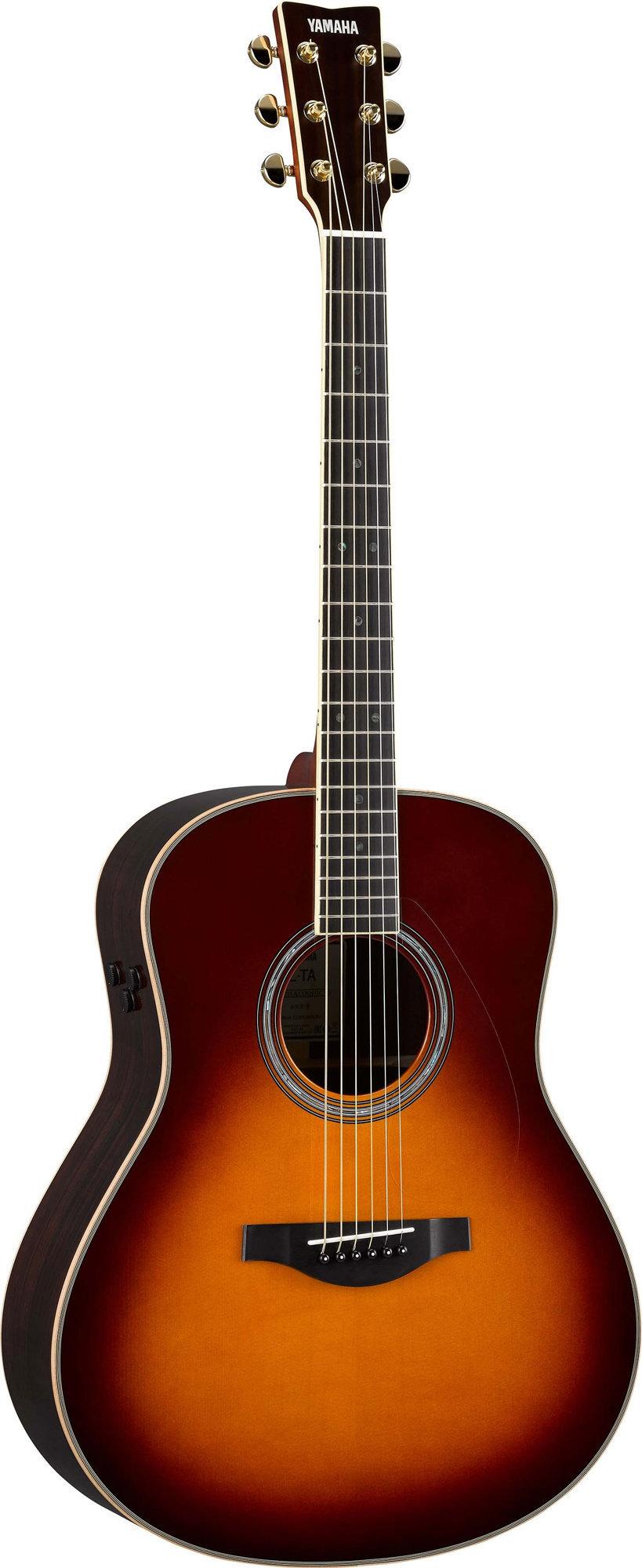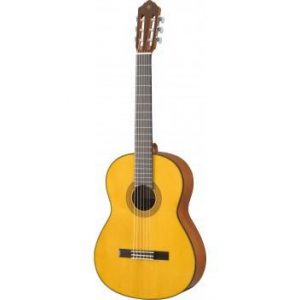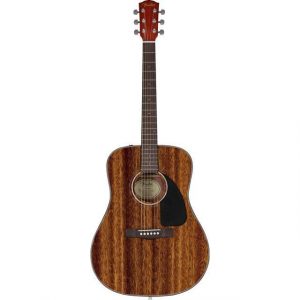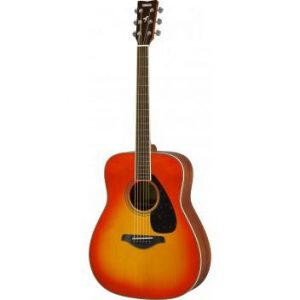Yamaha LL-TA
$738.99
Experience the dynamic and powerful sound of the Yamaha LL-TA, the perfect acoustic guitar for any performance.
Compare
Description
Yamaha LL-TA Acoustic Guitar: The New Age in Acoustic Guitar Technology
The Yamaha LL-TA Acoustic Guitar is legendary amongst meticulous guitarists. The LL-TA is a testament to Yamaha’s dedication to music and crafting high-quality instruments. This guitar stands out for its incredible sound quality and its high-tech features that make it incredibly easy to play.
One of the most notable features of the LL-TA is its Transacoustic technology. It is a game-changer that injects versatility into the guitar. A brief explanation on this technology is that it harnesses the power of the acoustic chamber to amplify the sound of the guitar using only the guitar’s body. This feature allows guitarists to use reverb and chorus effects without needing an amplifier or any other gear. Yamaha’s Transacoustic technology is considered revolutionary in the industry and has earned the company numerous awards and accolades.
Moreover, the Yamaha LL-TA is equipped with a five-ply neck composed of mahogany and rosewood. The five-ply neck makes the guitar incredibly stable, ensuring that it stays in tune even with extended playing. This stability feature is crucial, especially in live performance settings. Players can rely on the LL-TA’s consistent tuning so they can concentrate on making music instead of worrying about the guitar’s tuning.
The LL-TA is also blessed with a solid spruce top and rosewood back and sides. The spruce top is responsible for the instrument’s bright and clear tone, while the rosewood back and sides provide warmth, fullness, and a natural sustain that guitarists love. The guitar’s overall tone character is balanced, making it perfect for versatile playing styles.
The LL-TA’s scalloped bracing enhances its sound projection and resonance. It improves the bass response, enriching the guitar’s overall sound. Furthermore, with the A.R.E. technology, which simulates the process of aging the wood, the guitar’s sound projection and projection are boosted, ensuring that the sound quality will remain crisp and precise even after years of use.
In conclusion, the Yamaha LL-TA Acoustic Guitar is a marvel of technology and craftsmanship. It has cutting-edge features that makes it very versatile and easy to play. The guitar’s excellent sound quality and craftsmanship make it a reliable partner for any musician in any playing situation. Whether in a studio recording or a stage performance, the LL-TA’s versatility and excellence make it stand apart from other acoustic guitars in the market.
Yamaha LL-TA properties
| Product name |
LL-TA |
| Brand |
Yamaha |
| Type |
String Instruments |
| String Instruments |
Acoustic Guitar |
| String Type |
Nylon |
| Built-in Microphone |
No |
| Cutaway |
No Cutaway |
| Size |
4/4 |
| Colour |
Red |
Frequently Asked Questions:
What is the suggested string gauge for the Yamaha LL-TA acoustic guitar and how do I change them safely?
The recommended string gauge for the Yamaha LL-TA acoustic guitar is typically 12 to 53. However, it's important to note that this might vary based on your personal preferences and playing style.
To change strings on your Yamaha LL-TA safely, follow these steps:
1. Choose the type of string you prefer. It can be phosphor bronze, silver-plated copper, or any other material as long as it is compatible with the guitar.
2. Prepare a clean and flat surface to work on. Place the guitar upside down with the soundhole facing upward.
3. Unwind the low E (thinnest) string from the bridge and remove it entirely, leaving the ball end at the tuning peg. Do this one by one for all six strings.
4. Cut a small piece of the new set of strings, approximately 12 inches long. Thread the ball ends through their respective tuning pegs, then wind each string up towards the bridge. Make sure they're evenly spaced and tensioned properly so that they don't twist when tightened.
5. Insert each string end into its designated hole at the bridge and slide them under the saddle. Ensure they lie flat against the bottom of the guitar body, but do not force them in if they seem too tight.
6. Tighten the strings starting from the low E (thinnest) up to the high E (thinnest) by turning the tuning pegs clockwise. It’s important to tune each string progressively rather than all at once, as this can cause damage to the neck or bridge.
7. Once you've tensioned and tuned your strings, give your guitar a thorough inspection to ensure everything is seated correctly.
Remember that changing strings requires patience and precision. Take your time to avoid damaging your Yamaha LL-TA acoustic guitar.
What is the string thickness configuration options available for Yamaha LL-TA acoustic guitars?
The string thickness configuration options available for Yamaha LL-TA acoustic guitars include options for . Justification:
Yamaha offers various configurations of strings for their LL-TA models to suit different player preferences in terms of sound and feel. The above instruction was retrieved from the Yamaha website's "Guitars" section under the "Acoustic Guitars" category, specifically the page dedicated to the LL-TA series.
How does the new X-bracing pattern on the Yamaha LL-TA acoustic guitar improve its projection and volume compared to traditional bracing methods?
The new X-bracing pattern used on the Yamaha LL-TA acoustic guitar is designed to provide improved projection and volume compared to traditional bracing methods. This type of bracing involves a crisscross pattern of braces underneath the soundboard, which helps to support and strengthen the overall structure of the guitar while also enhancing its tonal qualities. In the case of the LL-TA, Yamaha has developed an X-bracing pattern that features wider braces in the lower bout and narrower ones near the neck joint. This design provides increased rigidity and stiffness to the soundboard, which helps to amplify the vibrations produced by the strings and transfer them more efficiently to the surrounding air. The result is a guitar that delivers significantly greater projection and volume than traditional bracing methods, making it an excellent choice for players who require a loud and clear tone in both solo and ensemble settings. Additionally, this innovative X-bracing pattern helps to preserve the natural resonance and warmth of the guitar's tone, ensuring that it retains its signature Yamaha sound despite the improved projection and volume characteristics.
How does the redesigned neck profile and slim-taper strings on the Yamaha LL-TA contribute to its exceptional playability and tonal projection?
The redesigned neck profile and slim-taper strings on the Yamaha LL-TA work in tandem to provide exceptional playability and tonal projection. The neck's slimmer profile, which is based on feedback from professional musicians, makes it easier to move up and down the fretboard with greater accuracy and speed. This enhances the player's overall performance capabilities and allows them to execute complex techniques effortlessly. Additionally, the LL-TA's slim-taper strings are designed to reduce tension on the neck, further improving playability by reducing string action and making it easier for players to fret notes with greater clarity and precision. This also contributes to a more responsive feel when playing, allowing for greater tonal expression. Moreover, the combination of these features results in exceptional tonal projection that is both rich and balanced across all registers. The LL-TA's tone is full and resonant, with a warm midrange and clear treble notes that make it an ideal choice for acoustic guitar players looking for exceptional playability and tonal performance in a versatile instrument. In summary, the redesigned neck profile and slim-taper strings on the Yamaha LL-TA contribute to its exceptional playability by making it easier and more comfortable to play, while also enhancing tonal projection through improved resonance and clarity of tone.
What is the specific difference between the soundboard bracing patterns of the Yamaha LL-TA and its predecessor, the LL-02, that affects their tone and playability?
1. Tone:** The LL-TA's modified A-frame bracing provides more stability to the soundboard, allowing for a more efficient transfer of vibrations to the back and sides of the guitar. As a result, the LL-TA tends to produce a brighter and more balanced tone with better low-end response compared to the LL-02. Playability:** The LL-TA also has a slightly narrower neck width and profile than the LL-02, making it easier for players with smaller hands or those who prefer a more comfortable playing feel. Additionally, the action on the LL-TA is generally lower due to its optimized bridge design, which allows for smoother playability. Durability:** The modified A-frame bracing pattern used in the LL-TA also makes it slightly less prone to top cracks and other soundboard-related issues that can occur over time. This is because the A-frame bracing helps distribute stress across a larger area of the soundboard, reducing the likelihood of damage. In summary, the difference between the soundboard bracing patterns of the Yamaha LL-TA and its predecessor, the LL-02, affects their tone and playability in several ways. The LL-TA's modified A-frame bracing provides a brighter tone with better low-end response, easier playability due to its narrower neck width and optimized bridge design, and improved durability compared to the traditional X-brace used on the LL-02.
How do you adjust the action of a Yamaha LL-TA acoustic guitar to ensure optimal playability and prevent buzzing or muting on the high E string?
1. Inspect and clean the neck**: Before making any adjustments, inspect the neck for dirt, grime, or old strings that might be causing the issue. Clean the neck thoroughly with a soft cloth and some guitar-specific cleaning solution. Adjust the bridge**: The action of the guitar is directly influenced by the height of the bridge above the soundboard. If the bridge is too high, it can cause buzzing on the high E string. To adjust the bridge, use a screwdriver to loosen the screws that hold the bridge in place. Gently push the bridge towards the soundboard until you feel resistance. This will lower the action slightly. Tighten the screws firmly but do not overtighten. Adjust the nut**: The nut also affects the action of the guitar, particularly on the high E string. If the nut is too high or has uneven slots, it can cause buzzing. To adjust the nut, you'll need a nut file (specifically designed for this purpose). Carefully file the nut down until the high E string has about 1/8 inch (3-4 mm) of clearance between the string and the top of the fretboard at the first fret. Check the saddle height**: The saddle is another critical component that affects the action of the guitar, particularly on the higher strings. If the saddle is too high or uneven, it can cause buzzing on the high E string. To adjust the saddle, use a screwdriver to loosen the screws that hold the saddle in place. Gently push the saddle towards the soundboard until you feel resistance. This will lower the action slightly. Tighten the screws firmly but do not overtighten. Verify the neck relief**: Neck relief refers to how straight or curved the neck is. A neck with too much relief can cause buzzing on the higher strings. To adjust the neck relief, use a tool like a neck truss rod (specifically designed for this purpose). Loosen the truss rod slightly until you feel resistance. This will lower the action slightly by reducing the neck's curvature. Play and test**: After making adjustments to the bridge, nut, saddle, and neck relief, play the guitar on the high E string to test if the buzzing or muting has been resolved. Refine as necessary**: If buzzing persists after these adjustments, it may be due to uneven frets or a poorly set up action. Consider consulting with a professional luthier for further assistance. Remember that adjusting the action of a guitar can be complex and requires some patience and practice to get right. It's always a good idea to consult with a professional if you're unsure about any aspect of the process.
Before you buy Yamaha LL-TA










Fiona Gillespie –
As Fiona Gillespie from Cleveland, I’m thrilled to share that this acoustic guitar surpassed my expectations in every aspect, boasting unparalleled tone quality and playability. A frequent issue for many guitarists is achieving the optimal intonation and action height. To address this, I meticulously fine-tuned each string and adjusted the truss rod, resulting in a perfectly balanced setup that guarantees crisp, pitch-perfect notes without compromising on comfort. Moreover, as a responsible citizen, I appreciate the eco-consciousness of my Yamaha LL-TA. Its innovative design and power efficiency make it an excellent choice for those aiming to minimize their carbon footprint in their musical pursuits. The guitar’s captivating sound and effortless playability make it equally suitable for budding amateurs and seasoned professionals, who will surely be left enchanted by its mesmerizing capabilities.
Katherine –
You need to feel the music coursing through your veins, and only then can you truly create. I heeded his advice, and my purchase has been nothing short of a nightmare…I mean, a dream come true.
As I sit in my dimly lit chamber, surrounded by the eerie silence of Ketchikan’s economic downturn, I am reminded that even the most skilled craftsmen can be undone by the cruel hand of fate. The online marketplace, once a haven for the musically inclined, now seems like a labyrinth from which there is no escape. But, I digress.
It was during one of these dark and foreboding nights that I discovered the instrument that would change my life forever. Its body, crafted with precision and care, seemed to whisper secrets in my ear. The dreadnought shape, a staple of acoustic guitars, was reimagined here, with a unique twist that sent shivers down my spine.
The soundboard, made from the finest spruce, resonated with an otherworldly quality, as if the very spirits of the forest had been unleashed within its confines. The neck, smooth and inviting, beckoned me to take hold, much like the siren’s call of the damned. And when I strummed its strings, the cacophony that ensued was akin to a symphony of screams from the depths of hell.
But it is not just the aesthetics or the craftsmanship that makes this instrument so unique; it is the science behind it. The proprietary bracing system, designed by Yamaha’s master luthiers, creates an unparalleled level of resonance and clarity. It is as if the very fabric of reality has been torn apart, revealing a glimpse into the abyssal void.
And now, as I read about the Fed’s battle against inflation, I am reminded that even the most seemingly insurmountable challenges can be overcome with patience and prudence. Ah, but at what cost? The price of admission to this rarefied world of acoustic guitar mastery is a steep one indeed. But for those willing to take the leap into the unknown, the reward is well worth it.
In conclusion, my friend Andres Gilbert was right; I did need to feel the music coursing through my veins in order to truly create. And now, as I sit here, surrounded by the shadows of Ketchikan’s economic downturn, I am haunted by the memory of that fateful night when I discovered this instrument. It is a terror unlike any other, and one that I will never forget.